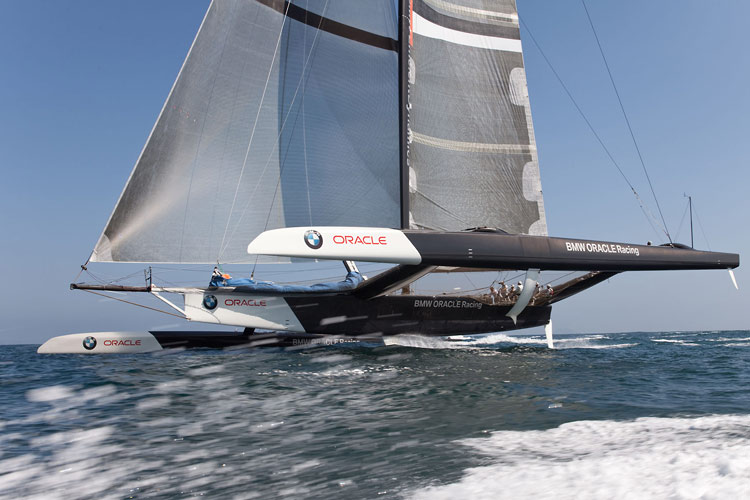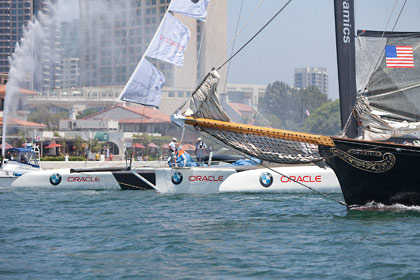|
August, 2009 |
|||||||||||||||||||||
BOR-90 moves fast. Frighteningly fast. Especially when she’s is coming right at you. Zero-to-gone in a moment. That’s the biggest takeaway from the media day at BMW Oracle Racing’s compound in San Diego, the sheer magnitude, the mammoth size and power of this trimaran dubbed “The Beast” –- and the team’s healthy respect for that size and power. There was the usual pomp and circumstance at this celebration of the team and the campaign for the 33rd America’s Cup –- tours, speeches, champagne toasts, even a “networking reception” as a nod to the times. But the centerpiece both literally and figuratively was the 90-foot monster trimaran soon to be christened USA.
“It ages you,” said James Spithill, now the officially-designated helmsman. Spithill has grown up in the game, sailing with America’s Cup teams since the tender age of 20. Brimming with confidence and leading a team of Cup veterans that include Sir Russell Coutts and John Kostecki, Spithill acknowledges the steep learning curve the team is on and the need to always keep one step away from the edge. “It really is all about the boat,” says Spithill, glancing behind him where a low schooner, a replica of the first yacht to win the historic trophy, sat waiting. “You look at the America and you look at where we are today, it’s a pretty amazing contrast.“It’s an incredible boat to sail, very, very powerful. Any multihull sailor will tell you that you really have to be on the edge to be going fast in these boats, but it’s an interesting balance that we live with each day -- you have to push a boat of this size, but a small mistake could lead to the end of the campaign. But it’s a rewarding boat -- the performance side, the boat speeds, there’s nothing like it. It’s the best sailing I’ve ever done.” The team doggedly pursues full optimization of this boat every day, on the ocean between the Coronados and Del Mar, with a typical eight hour session –- sailing distances anywhere from 70-90 miles -- garnering about 90 minutes of usable data. “You push the boundaries of boats and the construction in the Cup,” says Spithill, “but this boat is extreme engineering. When you see the boat completely loaded up, flying a hull, you really wonder how it does it. What makes these multihulls so fast is you have the stability of such a wide platform without the drag penalty of the hull in the water. Sailing a multihull is all about getting that middle hull out and doing it as soon as you can.” When asked about how close they’ve come to finding “the edge” on the boat, getting to the maximum heel angle while keeping the boat upright, Spithill visibly shuddered. “We are hoping not to discover that. There is a certain heel angle [that is the edge] -- it’s all theoretical and based on modeling. But to be honest, to sail this boat fast, you don’t have to be that close to the edge. We’ve certainly pushed the boat hard. We set a record yesterday. But it’s always in the back of your mind. You really have to think a couple of steps ahead, because it doesn’t take long before you have a lot on in this boat. It’s a tough balance between how hard you push the boat and safety.” Spithill points to the smaller boats as the place to exceed limits and find out where those edges really are. It’s safer –- and much cheaper –- to go over that edge in an Extreme 40 or an A-cat. But that doesn’t mean they haven’t crept close with the trimaran. “We’ve pushed the heel angle a couple of times when launching downwind, but that’s to be expected,” said Spithill, smiling and clearing enjoying the challenge. “You have to have a few little scares without being stupid. “We’ve sailed in up to 40 knots of wind speed –- not on purpose! We were out there one day and we got stuck in a squall. We had a little bit on, but we got through it and lived to tell the tale. We obviously learned a few things that day. These boats, though big and powerful, can be sailed in the higher wind speeds.” When pressed, Spithill admitted that, yes, on that day, they were probably going faster than the most recent America’s Cup boats –- just while returning to the base on the mast alone. This kind of power and scale helps explain the helmets and life jackets, too, something unheard of in Cup racing until now.
Spithill constantly balances talk of pushing the edge with admonitions about safety, as though reminding himself about those flirting with those risks. Luckily, the boat and its more than one thousand sensors help remind him, too. “We have a really sophisticated optical alarm system –- so, say, if we go over a big wave, an onboard alarm will go off and we can see on the computers what is overloading and what we need to do. We set those off all day. “This mast is almost twice the length of the boat, so it’s certainly a handful on the water. On multihulls, you try to carry as much sail area as you can upwind and hold on for the ride downwind.” The sail area includes 6800 square feet of main sail, 6700 sf of genoa, and 8400 sf of gennaker. “Previous Cup boats were moded for upwind performance, trying to get to that first top mark in the lead and hold off to the finish, but multihull sailing is really about the downwind side. That’s usually where the gains are won. The masts come in Small, Medium, and Large; this current one apparently being the Large size. “This is our big rig,” Spithill said. “We’ve been sailing with this for a few weeks now and it’s become a standard. But it’s certainly a handful.” Time waits for no one and the clock is ticking on the approaching America’s Cup match, with barely six months until BMW Oracle meets Alinghi at Ras al-Khaimah in the United Arab Emirates (pending possible legal action). Spithill knows that with more modifications -- “significant” modifications -- on the way, time is running out to climb this steepest of learning curves. “It’s like any campaign, where we just can’t get enough time sailing the boat, but the one thing that’s different is how long everything takes to do. Everything is so big and so loaded –- just getting on and off the dock is an exercise.” While Spithill obviously won’t be drawn into a discussion of modifications to come, he did point out some of the changes to the boat completed earlier this year. “We’re testing wave-piercing bows on the floats –- you see them in smaller catamarans. It’s a windage gain and also a weight gain for the same waterline length. They’re probably the most striking difference on the floats. Definitely more slender, too. “The previous floats were more offshore floats, where the bow was spending more time above the water. These floats are more of an inshore racer type, more efficient and spending more time in the water, going through the waves instead of over them.”
And what about the proposed venue, an assumed light air venue, chosen by a defender who has purportedly designed a light air boat? Spithill hopes the racing, with its chance to be a visual spectacle, doesn’t turn into a drift-fest. “Racing these two boats is really an unknown –- we’ve done some training in Groupama II and Banco Populaire and while it was different than what we’re used to in the monohull America’s Cup, there was still some good racing and quite a lot of passing. “The biggest different will probably be the separation, because they go so fast, so it will be a huge racetrack. But the boats are very similar in their sizing so we could have one heck of a race –- as long as the breeze is decent. [Lighter breeze] is sort of like sailing an 18’ skiff in super-light winds and not being able to get out on the trapeze. It would be a shame -- the multihulls are really spectacular when you can power them up and really get them sailing.” Sailing fans can only hope. --- ©2009
Diane Swintal for CupInfo |
|||||||||||||||||||||
|
Also of Interest: "Dogzilla"
BMW Oracle Multi-Hull Photo Galleries: |



